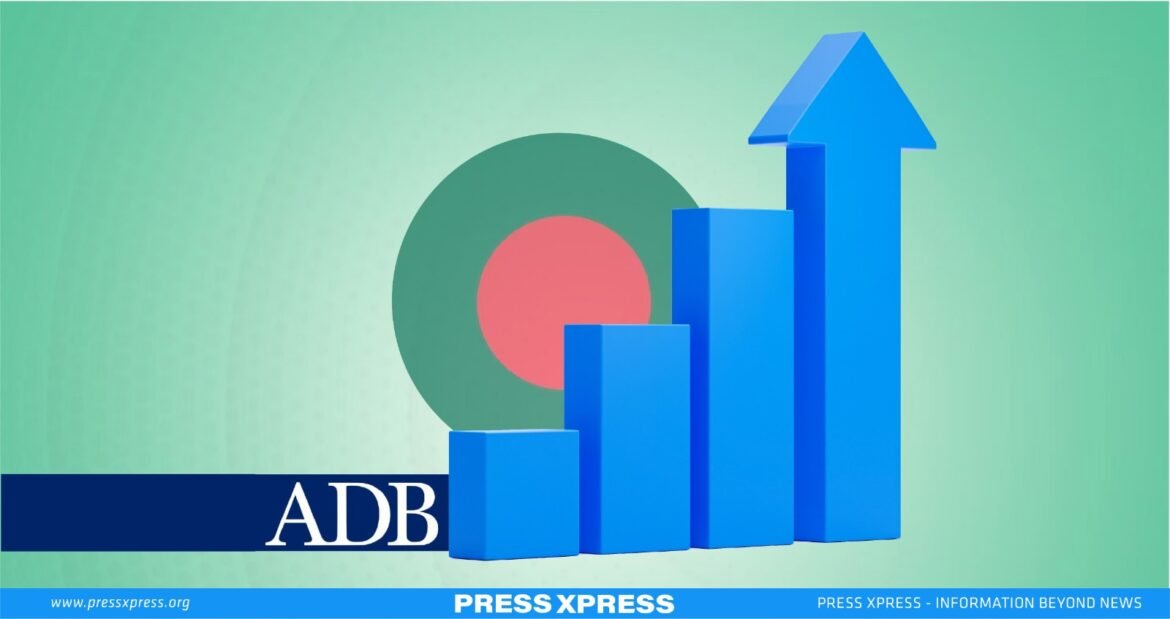Key Highlights:
- Developing economies in Asia expected to expand by 4.9%
- Inflation expected to moderate in 2024-25 after recent spikes
- India is expected to remain major growth engine
In the dynamic landscape of global economics, Bangladesh stands out as a beacon of growth, driven largely by its flourishing export sector. The Asian Development Bank (ADB) recently projected a robust GDP growth rate of 6.1 percent for Bangladesh in the fiscal year 2023-24, with expectations of further acceleration to 6.6 percent in the subsequent fiscal year. This growth trajectory underscores the pivotal role that exports play in shaping Bangladesh’s economic fortunes.
With an impressive GDP growth rate of 6.1 percent forecasted for the fiscal year 2023-24, Bangladesh showcases resilience and dynamism in its economic pursuits. A significant driver of this growth is the country’s burgeoning export sector, which has seen substantial expansion in recent years. The textile and garment industry, in particular, has emerged as a powerhouse, contributing significantly to Bangladesh’s export earnings and economic growth.

The Asian Development Outlook (ADO) April 2024, released by the ADB, paints a promising picture for the economies of Asia and the Pacific. Despite global uncertainties, developing economies in the region are expected to grow by an average of 4.9 percent this year, propelled by robust domestic demand, improving semiconductor exports, and recovering tourism.
Key Players: India and the People’s Republic of China
India stands out as a major growth engine in the region, with a projected expansion of 7.0 percent this year and 7.2 percent next year. However, the People’s Republic of China (PRC) is experiencing a slowdown, with growth forecasted to decline to 4.8 percent this year and 4.5 percent next year, primarily due to weakness in the property market and subdued consumption.

Navigating Risks and Challenges
While the economic outlook appears promising, policymakers must remain vigilant in the face of various risks. These include supply chain disruptions, uncertainties related to US monetary policy, extreme weather events, and further weaknesses in the property market of the PRC. Addressing these challenges requires proactive measures to sustain economic stability and growth momentum.

Inflation Dynamics
Inflation in developing Asia and the Pacific is expected to moderate, declining to 3.2 percent this year and 3.0 percent next year. However, persistent food inflation, particularly driven by rice prices, remains a concern for import-reliant economies. Policy measures such as targeted subsidies and enhanced market transparency are vital to mitigate the impact of rising food prices and safeguard food security.

Policy Recommendations
To tackle surging rice prices and ensure food security, governments can implement targeted subsidies for vulnerable populations and enhance market monitoring to prevent price manipulation. Moreover, long-term strategies focusing on establishing strategic rice reserves, promoting sustainable farming practices, and investing in agricultural technology are imperative to stabilize prices and enhance productivity.
Bangladesh’s Economic Growth

In the context of emerging Asian economies, Bangladesh often finds itself overlooked. With a total GDP of USD 460 billion, ranking second in South Asia, and a GDP per capita of USD 2,734, Bangladesh unmistakably demonstrates its economic potential.
On 20 September, the Asian Development Bank announced its revised growth forecast for Bangladesh’s economy, projecting a 6.5 percent growth rate for the current fiscal year. This update comes from the institution’s recently released “Asian Development Outlook (ADO) September 2023” report.
According to the ADB’s projections, Bangladesh’s GDP is set to expand at a rate of 6.5% in fiscal year 2024, surpassing the estimated 6% growth recorded in the previous fiscal year, 2023.
The Asian Development Bank (ADB) has reported that the growth outlook indicates an increase in domestic demand and a stronger export performance, propelled by the economic recovery in the Eurozone. In fiscal year 2022, Bangladesh’s economy experienced a surge from exports, remittances, and domestic consumption, leading to a 7.1% growth in gross domestic product, up from 6.9% in FY 2021.
The expansion of export-driven sectors plays a crucial role in driving Bangladesh’s economic growth. Substantial improvements in infrastructure and the establishment of Special Economic Zones and Export Processing Zones have significantly enhanced connectivity and created a more favorable business environment in the country.
The Ready-Made Garments (RMG) sector stands out as a key contributor to Bangladesh’s economy, accounting for an impressive 82% of the country’s total exports in 2023. Bangladesh’s robust export performance has enabled it to reach customers in 181 countries worldwide. Additionally, Bangladesh has effectively managed its debt burden.
Moreover, the government’s ambitious goal of achieving a trillion-dollar economy by 2040 underscores its dedication to long-term growth and development.
Conclusion
As Bangladesh continues to ride the export wave, its economy stands poised for sustained growth in the fiscal year 2023-24 and beyond. Regional cooperation, proactive policy measures, and strategic investments are essential to navigate the challenges and capitalize on the opportunities presented by the evolving economic landscape of Asia and the Pacific.


